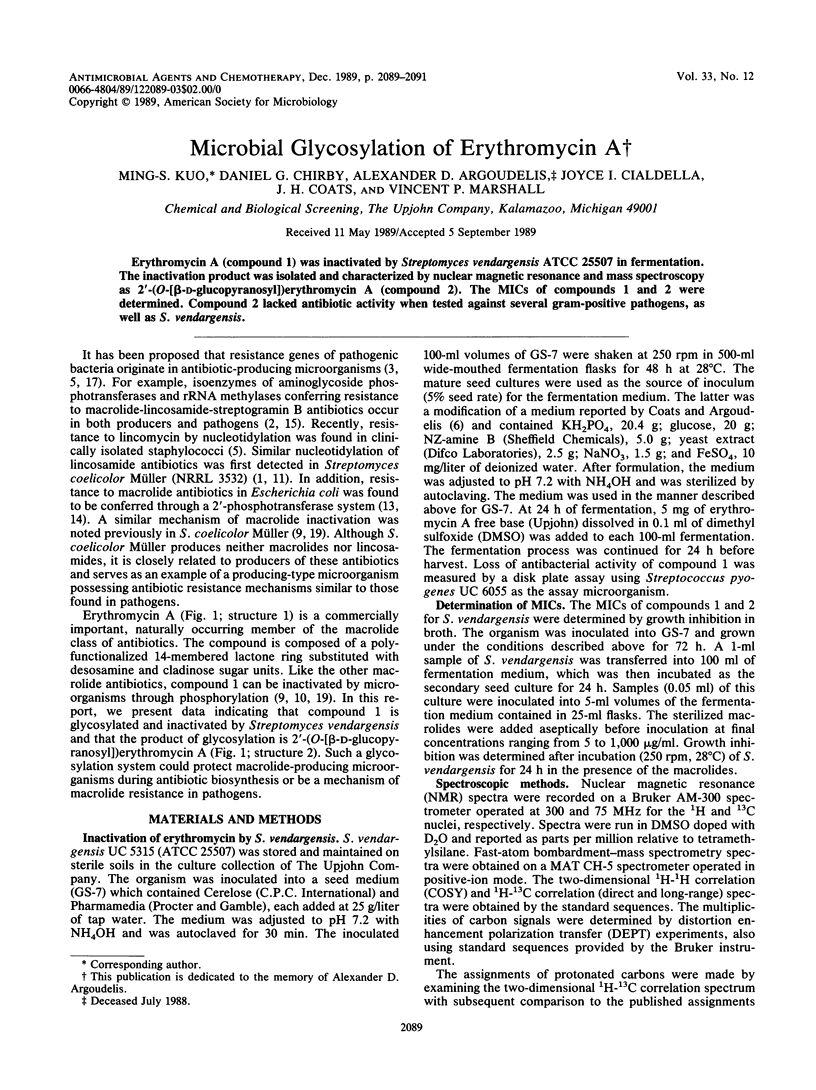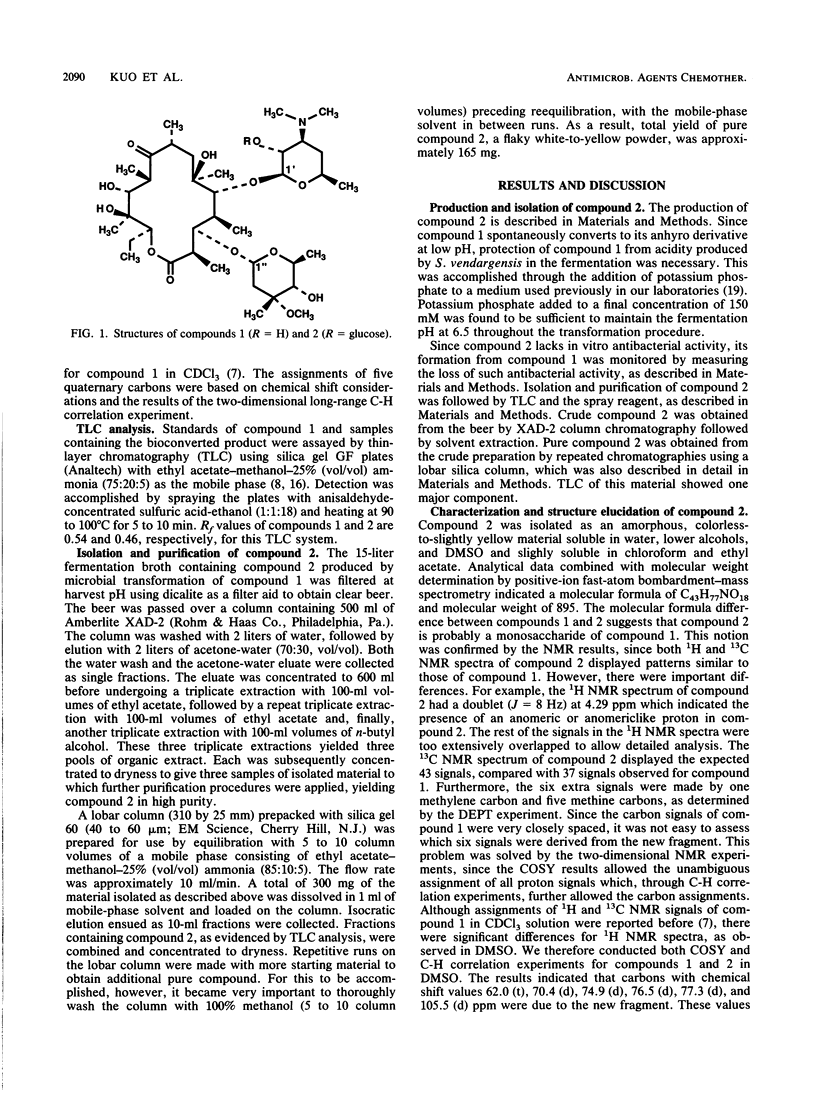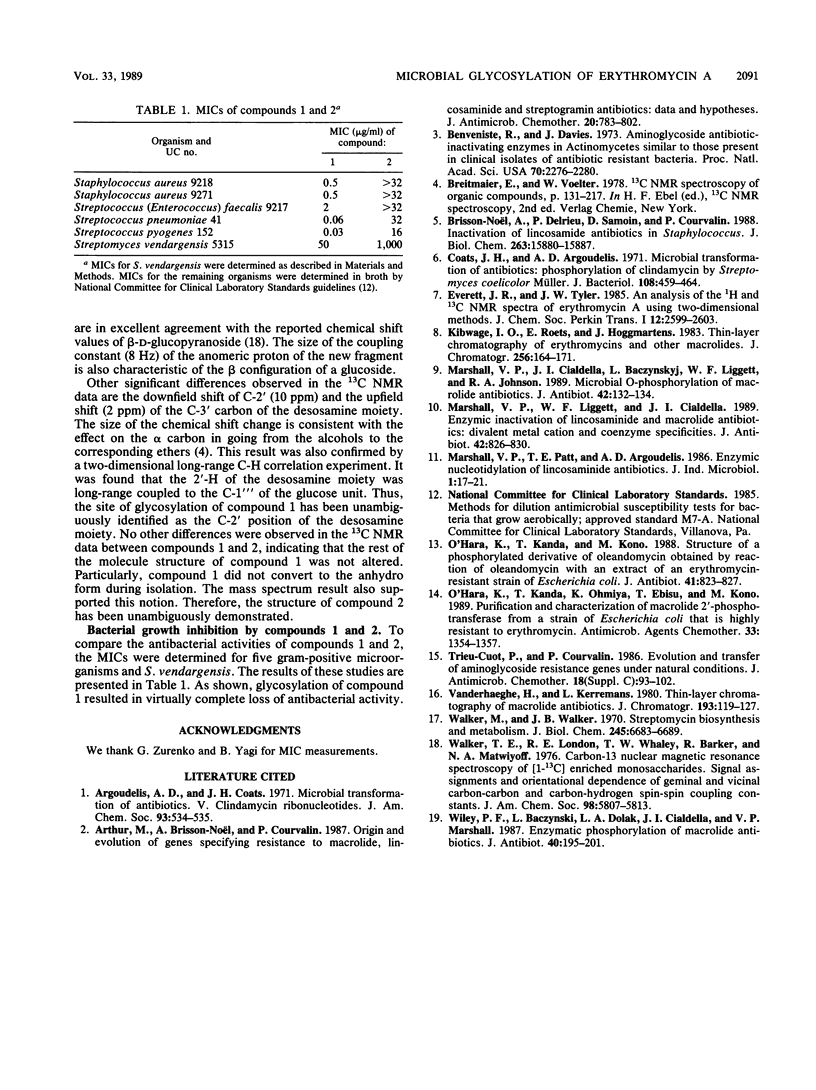Abstract
Erythromycin A (compound 1) was inactivated by Streptomyces vendargensis ATCC 25507 in fermentation. The inactivation product was isolated and characterized by nuclear magnetic resonance and mass spectroscopy as 2'-(O-[beta-D-glucopyranosyl])erythromycin A (compound 2). The MICs of compounds 1 and 2 were determined. Compound 2 lacked antibiotic activity when tested against several gram-positive pathogens, as well as S. vendargensis.
Full text
PDF


Selected References
These references are in PubMed. This may not be the complete list of references from this article.
- Argoudelis A. D., Coats J. H. Microbial transformation of antibiotics. V. Clindamycin ribonucleotides. J Am Chem Soc. 1971 Jan 27;93(2):534–535. doi: 10.1021/ja00731a047. [DOI] [PubMed] [Google Scholar]
- Arthur M., Brisson-Noël A., Courvalin P. Origin and evolution of genes specifying resistance to macrolide, lincosamide and streptogramin antibiotics: data and hypotheses. J Antimicrob Chemother. 1987 Dec;20(6):783–802. doi: 10.1093/jac/20.6.783. [DOI] [PubMed] [Google Scholar]
- Benveniste R., Davies J. Aminoglycoside antibiotic-inactivating enzymes in actinomycetes similar to those present in clinical isolates of antibiotic-resistant bacteria. Proc Natl Acad Sci U S A. 1973 Aug;70(8):2276–2280. doi: 10.1073/pnas.70.8.2276. [DOI] [PMC free article] [PubMed] [Google Scholar]
- Brisson-Noël A., Delrieu P., Samain D., Courvalin P. Inactivation of lincosaminide antibiotics in Staphylococcus. Identification of lincosaminide O-nucleotidyltransferases and comparison of the corresponding resistance genes. J Biol Chem. 1988 Nov 5;263(31):15880–15887. [PubMed] [Google Scholar]
- Coats J. H., Argoudelis A. D. Microbial transformation of antibiotics: phosphorylation of clindamycin by Streptomyces coelicolor Müller. J Bacteriol. 1971 Oct;108(1):459–464. doi: 10.1128/jb.108.1.459-464.1971. [DOI] [PMC free article] [PubMed] [Google Scholar]
- Marshall V. P., Cialdella J. I., Baczynskyj L., Liggett W. F., Johnson R. A. Microbial O-phosphorylation of macrolide antibiotics. J Antibiot (Tokyo) 1989 Jan;42(1):132–134. doi: 10.7164/antibiotics.42.132. [DOI] [PubMed] [Google Scholar]
- Marshall V. P., Liggett W. F., Cialdella J. I. Enzymic inactivation of lincosaminide and macrolide antibiotics: divalent metal cation and coenzyme specificities. J Antibiot (Tokyo) 1989 May;42(5):826–830. doi: 10.7164/antibiotics.42.826. [DOI] [PubMed] [Google Scholar]
- O'Hara K., Kanda T., Kono M. Structure of a phosphorylated derivative of oleandomycin, obtained by reaction of oleandomycin with an extract of an erythromycin-resistant strain of Escherichia coli. J Antibiot (Tokyo) 1988 Jun;41(6):823–827. doi: 10.7164/antibiotics.41.823. [DOI] [PubMed] [Google Scholar]
- O'Hara K., Kanda T., Ohmiya K., Ebisu T., Kono M. Purification and characterization of macrolide 2'-phosphotransferase from a strain of Escherichia coli that is highly resistant to erythromycin. Antimicrob Agents Chemother. 1989 Aug;33(8):1354–1357. doi: 10.1128/aac.33.8.1354. [DOI] [PMC free article] [PubMed] [Google Scholar]
- Trieu-Cuot P., Courvalin P. Evolution and transfer of aminoglycoside resistance genes under natural conditions. J Antimicrob Chemother. 1986 Oct;18 (Suppl 100):93–102. doi: 10.1093/jac/18.supplement_c.93. [DOI] [PubMed] [Google Scholar]
- Walker M. S., Walker J. B. Streptomycin biosynthesis and metabolism. Enzymatic phosphorylation of dihydrostreptobiosamine moieties of dihydro-streptomycin-(streptidino) phosphate and dihydrostreptomycin by Streptomyces extracts. J Biol Chem. 1970 Dec 25;245(24):6683–6689. [PubMed] [Google Scholar]
- Wiley P. F., Baczynskyj L., Dolak L. A., Cialdella J. I., Marshall V. P. Enzymatic phosphorylation of macrolide antibiotics. J Antibiot (Tokyo) 1987 Feb;40(2):195–201. doi: 10.7164/antibiotics.40.195. [DOI] [PubMed] [Google Scholar]


